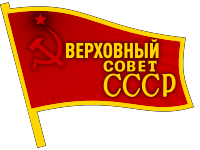
Back مجلس السوفيت الأعلى Arabic Sóviet Supremu de la Xunión Soviética AST SSRİ Ali Soveti Azerbaijani СССР Юғары Советы Bashkir Вярхоўны Савет СССР Byelorussian Върховен съвет на СССР Bulgarian Soviet Suprem de la Unió Soviètica Catalan Nejvyšší sovět Sovětského svazu Czech Sovjetunionens Øverste Sovjet Danish Oberster Sowjet der UdSSR German
The Supreme Soviet of the Union of Soviet Socialist Republics (SSUSSR)[a] was the highest body of state authority of the Soviet Union (USSR) from 1936 to 1991. Based on the principle of unified power, it was the only branch of government in the Soviet state.
Prior to 1936,[3] the Congress of Soviets was the supreme legislative body. During 1989–1991 a similar, but not identical structure was the supreme legislative body. The Supreme Soviet appointed the Council of Ministers, the Supreme Court, and the Procurator General of the USSR as well as elected the Presidium which served as the USSR's collective head of state under both the 1936 and 1977 Soviet Constitutions.[3]
By the Soviet constitutions of 1936 and 1977, the Supreme Soviet was defined as the highest organ of state power in the Soviet Union and was imbued with great lawmaking powers. In practice, however, it was a toy parliament which did nothing other than ratify decisions already made by the USSR's executive organs and the Communist Party of the Soviet Union (CPSU) – always by unanimous consent[3] – and listen to the General Secretary's speeches.[3] This was in accordance with the Stalinist CPSU's principle of democratic centralism and became the norm for other Communist legislatures.
- ^ "Совместное заседание Совета Союза и Совета Национальностей Верховного Совета СССР восьмого созыва. Кремль". RIA Novosti Mediabank. Rossiya Segodnya media group. 18 December 1972. Retrieved 29 April 2023.
- ^ "Совместное заседание Совета Союза и Совета Национальностей третьей сессии Верховного Совета СССР девятого созыва. Кремлевский Дворец Съездов (ныне – Государственный Кремлевский дворец)". RIA Novosti Mediabank. Rossiya Segodnya media group. 22 July 1975. Retrieved 29 April 2023.
- ^ a b c d Armstrong, John Alexander (1986) [1978]. Ideology, Politics, and Government in the Soviet Union: An Introduction (4th ed.). Lanham, MD / New York City / London: University Press of America. ISBN 0-8191-5405-9. Retrieved November 26, 2016.
Cite error: There are <ref group=lower-alpha> tags or {{efn}} templates on this page, but the references will not show without a {{reflist|group=lower-alpha}} template or {{notelist}} template (see the help page).



